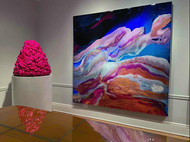Artist Interview: Miranda Pissarides on her practice and why she loves Art Resin
Posted by Cass Art on 4th Aug 2020
Miranda Pissarides is one to watch! Graduate of the Slade School of Fine Art UCL in 2012 and winner of the Saatchi Young Artist Prize in 2018, Miranda has exhibited across the world – from London to Italy, New York and Japan. We caught up with Miranda to chat about her work, discussing everything from her love of colour to her use of Art Resin to create her monolithic sculptures and other worldly surfaces.
Firstly, could you tell us a bit about your journey as an artist?
My journey as an artist started at selling my first painting - age 7. Donating the money to the RSPCA, (much to my parent’s dismay), and from then onwards. I’m not sure much has changed.
We’re asking our community how they’re staying creative during the current climate. What are your top tips for keeping a creative headspace right now?
It's been such a strange time. I think it's really important to just take each day as it comes. If you can't work the way you usually do, i.e. in a studio, try and adapt the way you work to your current setting. Creatively it's always great to try new things!

Your practice is so vast I’m not sure where we should start! From sculpture, to painting, photography, mosaic and even ethical taxidermy it seems that you throw yourself into a plethora of working mediums. When you’re approaching a new work would you say that the concept drives the medium, or the medium drives the concept? Or is it a natural back and forth between the two?
My aim with every work is to focus on that work specifically. I might have the subconscious insight of past work, medium and experience but really my predominant concern is: what am I trying to express and how best can I express that?

In each mode of your practice your hand as the artist is very present. There is an analogue approach to all of your work, from the placement of individual mosaic tiles, a tactile painting or a 35mm film hand developed. How important is this presence to you as an artist?
I’m glad you asked because it’s very important to my work! Thankful that my hands haven’t been destroyed for nothing. Honestly speaking anyone reading please wear gloves. It’s either a blessing or a curse that I want to feel and touch absolutely everything I am making, mixing and doing. I have to know my material, right? I need to know it’s the best it can be, the right consistency, the exact colour and precise shades I want. If I didn’t do that it just wouldn’t be honest.
Sometimes I wish I could just pick up a paintbrush and be happy

Are there any particular avenues you’re focussing on at the moment?
Everything I do is a continuation and (more importantly) a progression from what I have done last. That’s really fundamental to my journey going forward.
Resin is a material that appears across your paintings and sculpture, what is it about resin you enjoy as a material?
Right now, Art Resin is a vehicle which helps me to portray the sensation and depth of what I am trying to perceive in my work.

And what are some of your other go-to essentials, are there any brands you turn to?
I’m very into my pure pigments, and natural pigments. I like seeing a colour and driving myself crazy trying to recreate it. As for brands, I trust anything from Cass Art! If I had to buy tube paint it would be Michael Harding or Winsor & Newton- depending on the shade.
What is it about them that you love to use?
Michael Harding uses the highest pigment concentration in any of the oil paints sold at Cass Art. His colours will be the most lightfast of all. They are a higher price bracket though, and bearing that in mind I also really love Winsor & Newton oil paints.

As we’re in the colour business at Cass Art we can’t resist to talk pigment! Colour seems to play an important role in your work, your paintings a wash of vibrant pigments clash, swirl and merge into one another on your surfaces. And your sculptures act as monolithic celebrations of colour - with vivid gleaming opera rose and globules of cerulean blues. Could you talk us through how you approach colour in your work?
I could talk for hours, days, weeks, about pigment so I’m going to try really hard to be strict with myself! I love colour. It’s probably the most important, fundamental and exciting aspect of my everyday life. I really like my dog too but he is also a great colour, so I’m not sure which comes first. I can see about 55 variations of pigment shades in his eyes. They’re akin to iridescent and multi-faceted pigments; a pigment that contains many different nuances and colours depending on the lighting, what is surrounding it, the surface underneath. It’s amazing to see one colour and suddenly see another, and another after that! Experiences like this remind me that as much as we can take pigments and use them to describe what we want, ultimately the pigment has a life of its own.
A huge development in my practice has been relinquishing control in this aspect. I don’t do this often, but pigment is an exception. To recognise that a pile of dust (pigment) is stronger and more independent than us humans can ever be is all at once a strange and humbling experience.
Feeling Inspired?
Want to try you hand at your own Miranda Pissarides Inspired piece? Explore our Art Resin range.
Discover more of Miranda's work on her website




